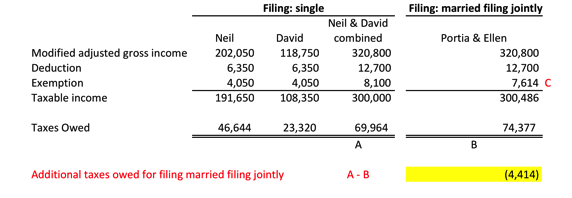The End of An Era: Goodbye Marriage Penalty
50 years. That’s how long it took to get rid of the “marriage penalty” in our federal tax system. What’s even worst is that some people never even knew it existed. The marriage penalty arose if two married individuals, both earning income, paid more in taxes if they file with under “married filing jointly” than if they filed taxes separately under the “single” tax status. How is this possible? It’s because the income tax brackets from single status did not rise in proportion to the marriage filing jointly tax bracket. See the chart below.
Notice that in 2017, the tax brackets don't just double from single to married filing jointly like they do in most of the brackets for 2018 except for the 37% tax bracket.
I first ran into the marriage penalty when my husband and I filed our first joint return. The year was 2011 and the idea of Donald Trump being president hadn’t come to real life yet; it was only a storyline on The Simpsons. I had a few working years under my belt and consistently set myself up to get a small refund during tax time. I liked it that way; it felt like a little bonus. So I was shocked when I starting doing our taxes and it was showing that we owed money! Worst yet, I think we may have even owed penalties for underpayment! Double whammy! It wasn’t as dramatic as the $4,000 change I show in in the example below, but it was still an unexpected blow. Fortunately, a lot less couples will be hit with this surprise penalty starting in the 2018 tax year. So in memoriam, I would like to recount the old tax law one more time and usher in the new glorious era brought to you by Mr. Trump.
The Old Tax Law (2017)
Let’s take an example to showcase how the marriage penalty shows up.
In scenario 1 – Neil and David (we’re being progressive here) have taxable incomes of $191,650 and $108, 350, respectively. If they file their taxes as individuals, they get taxed $46,644 and $23,320, respectively. Combined, their total tax bill comes to $69,964.
In scenario 2 – Portia and Ellen have a combined taxable income of $300K. They file "married filing jointly" and end up with a tax bill of $74,377. That’s $4,414 more in taxes than Neil and David. The only difference was that Portia and Ellen filed a joint tax return.
C. For the 2017 tax year, the tax brackets weren't the only thing that didn't rise proportionally when someone gets married. The exemption phaseout amount was also in the same category so Portia & Ellen can't take the full exemption in their income tax calculation.
You see, since Neil and David filed as single individuals, the maximum either one of them ever reaches is the 28% marginal income tax bracket. Portia and Ellen on the other hand, get bumped to the 33% marginal tax bracket because they are filing married filing joint and as I noted above, the tax brackets don’t just double from individual to married filing joint. That’s a 5% increase in the marginal tax bracket just for simply checking the married box over the single box!
The New Tax Law (2018)
Luckily, Trump’s tax plan (formally called the Tax Reform and Jobs Act of 2017) changed the income tax bracket system to do away with the marriage penalty (for the most part). Income tax brackets now double from individual to married file joint filers up to the 37% tax bracket. Unfortunately, the marriage penalty isn’t eliminated for all brackets. The marriage penalty continues to exist for a couple that has a combined taxable income of $600,000. I guess the tax man assumed if you make that much money, you don’t care about an extra 2% on your tax bill for anything over $600,000.
The Times They Are A Changing
So with the change in the tax law, are my issues with this marriage penalty appeased? Somewhat. My gripe with the marriage penalty is that it penalized working families where both partners were working and each making a decent salary (say averaging $75k). I did some research into the subject and found a very interesting and thorough piece on the topic dating back to 1978. See link here. It traced the history of the marriage penalty to a change in tax law in 1969. I can only assume it took nearly 50 years to finally do away with the marriage penalty because the majority of couples were not effected by it and therefore it was not at the forefront of their Congressmen (or Congresswomen's) priority list. Some couples may have even benefited from the “marriage bonus”, where a higher earning individual marries a lower earning spouse and the resulting effect is to bring them down to a lower bracket in the tax system.
I don’t know if we’ll ever be able to quantify the effect of the marriage penalty. How many people were discouraged from entering into marriage because of the penalty? Or how many people entered into marriage for the bonus? I also wonder whether one of the consequences of the old tax law was intentional or unintentional:
The plaintiffs further argued that they were denied equal protection because the marriage penalty creates a gender-based discrimination by which married female workers-who are generally the secondary wage earners-are taxed more severely than married male workers. (See source here.)
At this point, regardless of the original intent of the tax law that gave rise to the marriage penalty and marriage bonus, I’m glad the tax law has caught up and acknowledged (for the most part) that two working individuals shouldn’t be penalized simply for entering into the state of marriage. (Sorry super high-income earners). But next time we see a disparity like this let’s not take another 50 years to change it.
The marriage penalty arose if two married individuals, both earning income, paid more in taxes if they file with under “married filing jointly” than if they filed taxes separately under the “single” tax status. How is this possible? It’s because the income tax brackets from single status did not rise in proportion to the marriage filing jointly tax bracket.










